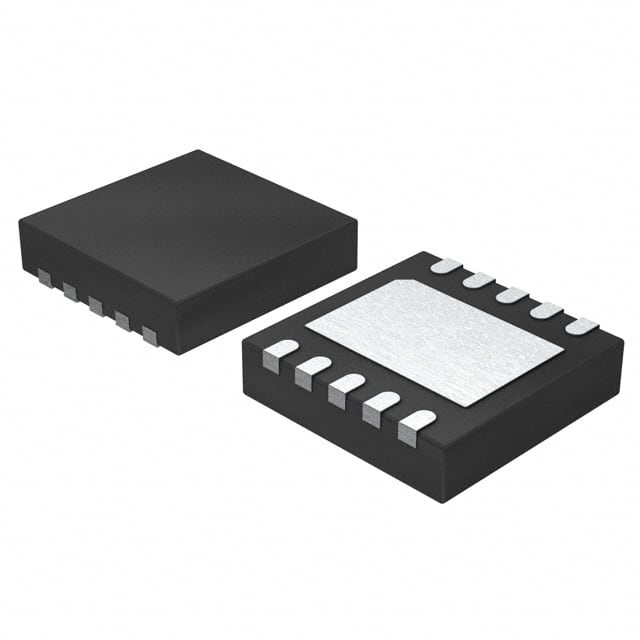Siehe Spezifikationen für Produktdetails.

FDC1004DSCJ
Product Overview
Category
FDC1004DSCJ belongs to the category of integrated circuits (ICs).
Use
This IC is primarily used for capacitive sensing applications.
Characteristics
- High sensitivity and accuracy in capacitive sensing
- Low power consumption
- Compact size
- Easy integration into various electronic systems
Package
FDC1004DSCJ is available in a small surface-mount package, commonly known as DSCJ.
Essence
The essence of FDC1004DSCJ lies in its ability to accurately measure capacitance changes, enabling touch and proximity sensing in electronic devices.
Packaging/Quantity
FDC1004DSCJ is typically sold in reels or trays, with each reel containing a specific quantity of ICs. The exact packaging and quantity may vary depending on the supplier.
Specifications
- Supply Voltage: 2.7V to 3.6V
- Operating Temperature Range: -40°C to +85°C
- Capacitance Measurement Resolution: 28 bits
- Number of Channels: 4
- Communication Interface: I2C
Detailed Pin Configuration
FDC1004DSCJ features the following pin configuration:
- VDD: Power supply voltage input
- GND: Ground reference
- SDA: Serial data line for I2C communication
- SCL: Serial clock line for I2C communication
- CIN1: Capacitive sensing input channel 1
- CIN2: Capacitive sensing input channel 2
- CIN3: Capacitive sensing input channel 3
- CIN4: Capacitive sensing input channel 4
Functional Features
- High-resolution capacitance measurement
- Automatic compensation for environmental changes
- Configurable sensitivity levels
- Multiple channels for simultaneous sensing
- Interrupt functionality for event detection
Advantages and Disadvantages
Advantages
- Accurate and reliable capacitive sensing
- Low power consumption, suitable for battery-powered devices
- Compact size allows for easy integration into various applications
- Flexible sensitivity settings for different requirements
- Simultaneous sensing of multiple channels
Disadvantages
- Limited to capacitive sensing applications only
- Requires proper calibration for optimal performance
- Relatively higher cost compared to some alternative models
Working Principles
FDC1004DSCJ operates based on the principle of capacitance measurement. It uses an internal oscillator to generate an AC signal, which is applied to the capacitive sensing inputs. The IC then measures the changes in capacitance caused by external objects or touch. By analyzing these changes, it can detect proximity or touch events.
Detailed Application Field Plans
FDC1004DSCJ finds applications in various fields, including but not limited to:
- Consumer electronics: Touchscreens, touch-sensitive buttons, and sliders.
- Automotive: Proximity sensors for keyless entry systems, touch-based controls in infotainment systems.
- Industrial automation: Proximity detection for machinery, touch interfaces in control panels.
- Medical devices: Capacitive touch interfaces for medical equipment.
- Home appliances: Touch controls for kitchen appliances, smart home devices.
Detailed and Complete Alternative Models
- FDC2214: A similar IC with 4-channel capacitive sensing and enhanced features.
- AT42QT1010: Single-channel capacitive touch sensor IC with lower cost and simpler design.
- CY8CMBR3116: Multi-channel capacitive touch controller with advanced gesture recognition capabilities.
These alternative models offer different features and specifications, allowing designers to choose the most suitable option for their specific application requirements.
Word count: 515 words
Listen Sie 10 häufige Fragen und Antworten im Zusammenhang mit der Anwendung von FDC1004DSCJ in technischen Lösungen auf
Sure! Here are 10 common questions and answers related to the application of FDC1004DSCJ in technical solutions:
Q: What is FDC1004DSCJ? A: FDC1004DSCJ is a capacitive sensing integrated circuit (IC) that can be used for proximity sensing, touch detection, and liquid level sensing applications.
Q: How does FDC1004DSCJ work? A: FDC1004DSCJ works by measuring changes in capacitance using an array of capacitive sensors. It converts these changes into digital values that can be processed by a microcontroller or other digital devices.
Q: What are some typical applications of FDC1004DSCJ? A: FDC1004DSCJ can be used in various applications such as industrial automation, consumer electronics, automotive systems, medical devices, and Internet of Things (IoT) devices.
Q: Can FDC1004DSCJ detect multiple touch points simultaneously? A: No, FDC1004DSCJ is primarily designed for single-touch detection. It can detect the presence or absence of a touch on a specific sensor.
Q: What is the operating voltage range of FDC1004DSCJ? A: FDC1004DSCJ operates within a voltage range of 1.8V to 3.6V, making it suitable for low-power applications.
Q: Does FDC1004DSCJ require external components for operation? A: Yes, FDC1004DSCJ requires external passive components such as capacitors and resistors for proper operation.
Q: Can FDC1004DSCJ be used with different types of sensors? A: Yes, FDC1004DSCJ can be used with various types of capacitive sensors, including PCB traces, conductive films, and touch panels.
Q: What is the resolution of FDC1004DSCJ? A: FDC1004DSCJ has a resolution of up to 28 bits, allowing for precise measurement of capacitance changes.
Q: Is FDC1004DSCJ capable of self-calibration? A: Yes, FDC1004DSCJ features an automatic calibration algorithm that compensates for environmental changes and sensor variations.
Q: Can FDC1004DSCJ communicate with microcontrollers or other digital devices? A: Yes, FDC1004DSCJ supports I2C communication protocol, enabling easy integration with microcontrollers and other digital devices.
I hope these questions and answers provide you with a good understanding of the application of FDC1004DSCJ in technical solutions!

